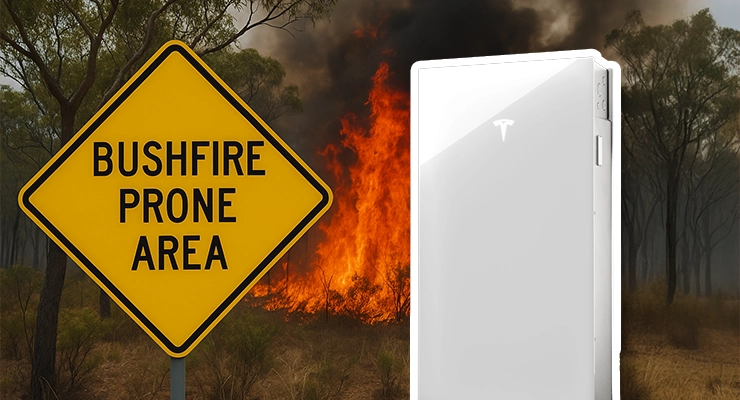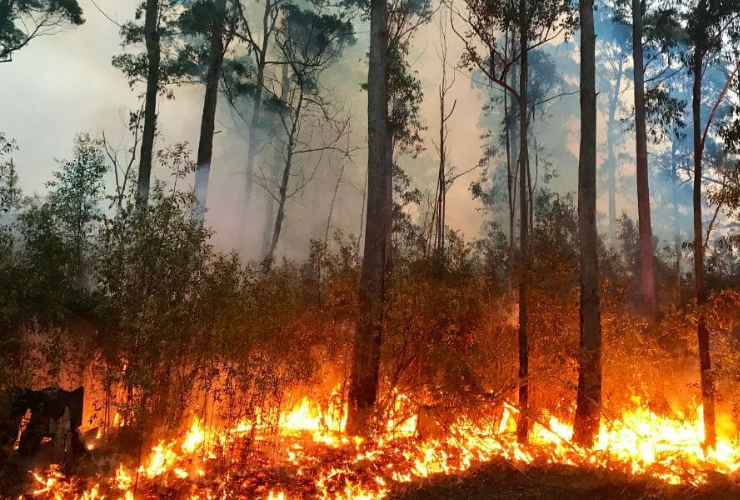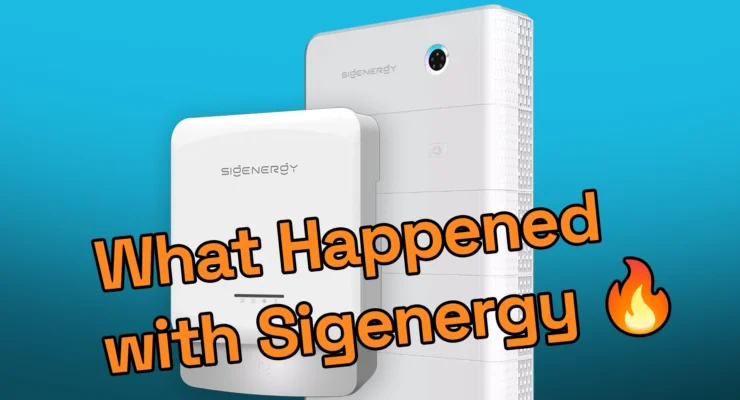Fast read
The safest approach for installing a battery in a bushfire-prone area involves three key elements: choosing a battery with inherently stable chemistry like Lithium Iron Phosphate (LFP), strictly adhering to the location and clearance rules in Australian Standard AS/NZS 5139, and using a qualified professional. To ensure eligibility for government programs, this means using an installer accredited by Solar Accreditation Australia (SAA) and ensuring the battery and other major components are on the Clean Energy Council (CEC) approved product lists. Your safest location is almost always outdoors, on a non-combustible wall or slab, and well away from flammable vegetation, windows, and doorways.
What’s the safest way and location to install batteries in bushfire-prone regions?
Living in a region susceptible to bushfires demands careful planning for every aspect of your home, and your energy system is no exception. For homeowners considering battery storage, the question of safety is paramount. A well-designed and properly installed battery system can be a huge asset, providing power during grid outages caused by fires, but an incorrect installation poses a significant risk.
This guide, based on Australian standards and industry best practices, will walk you through the critical considerations for safely installing a battery system in a bushfire-prone area, giving you the confidence to make a secure and resilient energy investment.
Why battery safety is critical in bushfire zones
The primary concern in a bushfire is extreme heat and potential exposure to flames. These conditions can damage a battery system, and in a worst-case scenario, lead to a dangerous event called thermal runaway. This is where a battery cell overheats, creating a chain reaction that is very difficult to extinguish.
Furthermore, emergency services need clear, safe access to your property. A poorly located battery could obstruct firefighters or become a hazard itself. The goal is to install the system in a way that it is protected from fire, and in turn, does not add to the risk profile of your home.
The foundation of safety: Choosing the right battery chemistry
Not all lithium-ion batteries are the same. For areas with a high risk of extreme heat, the choice of battery chemistry is your first and most important line of defence.
The industry consensus overwhelmingly recommends Lithium Iron Phosphate (LFP or LiFePO₄) batteries for these environments. LFP chemistry is inherently more stable and has a much higher thermal runaway threshold compared to other lithium chemistries like Nickel Manganese Cobalt (NMC). This means it can withstand higher temperatures before becoming unstable, making it a significantly safer choice for Australian conditions.
When discussing options with an installer, specifying that you will only consider LFP batteries is a crucial first step.
The safest installation location: Following the rules
The Australian Standard AS/NZS 5139:2019 is the rulebook for battery installation, and its guidelines are designed to maximise safety. For bushfire-prone areas, adhering to these rules is non-negotiable.
The standard strongly favours installing batteries outdoors. This provides natural ventilation and keeps any potential hazards outside of your home. The key location requirements include:
- On a non-combustible surface: The battery must be mounted on or against a fire-resistant surface, such as a brick wall, concrete slab, or a wall clad with cement sheeting.
- Clearance from windows and doors: The standard has specific clearance zones to keep exit paths clear and prevent smoke from entering the home. A battery must not be installed within 600mm of the vertical side of a window, door, or ventilation inlet to a habitable room, and it must be at least 900mm below such an opening.
- Away from flammable materials: There must be significant clearance from any flammable materials, including dry grass, shrubs, firewood stacks, and gas bottles.
- Protection from impact: The location should be protected from potential impacts, for example, from vehicles. This might involve installing a protective bollard if placing it in a carport.
- Shade and weather protection: While being outdoors, the battery must be shielded from direct sunlight and rain to prevent overheating and water damage, which can degrade the battery and create safety risks.
Can I install a battery in a garage or shed?
Installing a battery inside a garage or an attached shed is possible under the standards, but it adds layers of complexity and is often not the safest option in a bushfire zone. If an internal installation is considered, AS/NZS 5139 has strict requirements.
If there is a habitable room (like a bedroom or living area) on the other side of the garage wall where the battery is mounted, a special non-combustible barrier must be installed. The garage must also have adequate ventilation and, in some jurisdictions, may require the installation of a dedicated smoke alarm. Given these extra requirements, a carefully selected and protected outdoor location is generally the superior and more straightforward choice for safety.
Essential safety features and system design
Beyond location, the system itself must have layers of protection. A critical component is the Battery Management System (BMS), which acts as the brain of the battery. The BMS constantly monitors temperature, voltage, and current to ensure the cells operate within safe limits.
Reputable, modern battery systems are engineered with safety as a priority. For instance, some integrated systems, like those from Sigenergy, are designed with multiple layers of safety monitoring and robust, fire-resistant casing, which are crucial features to look for. These all-in-one units are factory-tested and sealed, reducing the risk of installation errors.
The most important safety step: Using accredited professionals and approved products
No amount of research can replace the expertise of a qualified professional. For a system to be safe, compliant, and eligible for government programs, it must meet key criteria regarding both the installer and the products used.
From 1 July 2025, the Australian Government’s Cheaper Home Batteries Program will allow eligible home battery systems to generate Small-scale Technology Certificates (STCs), providing an upfront discount. To be eligible, the installation must be certified on or after this date. It is a mandatory requirement that your battery system is installed by a Solar Accreditation Australia (SAA) accredited installer. SAA is the government-approved body responsible for accrediting solar and battery installers.
Furthermore, to be eligible for the STC program, the specific models of battery and inverter used must be on the Clean Energy Council (CEC) approved product list. This two-part requirement ensures both the installer’s competency and the product’s safety and quality have been verified. An accredited installer can assess your property’s specific risks, including its Bushfire Attack Level (BAL) rating, and design a compliant and safe installation.
Questions to ask your installer
To ensure your installer is prioritising safety, don’t hesitate to ask detailed questions.
- Are you accredited by Solar Accreditation Australia for battery installations?
- Do you use batteries and inverters from the Clean Energy Council’s approved product list?
- What is your experience installing batteries in bushfire-prone areas?
- Which LFP battery models do you recommend for my property and why?
- How will you ensure the proposed location complies with all clearance requirements of AS/NZS 5139?
- Can you walk me through the system’s emergency shutdown procedure?
- Will you provide a Certificate of Electrical Safety upon completion?
A safe and resilient energy future
Installing a battery in a bushfire-prone region requires a diligent, safety-first approach. By choosing the right battery technology (LFP), insisting on a compliant outdoor location, and engaging a certified, experienced installer who uses approved products, you can create a system that is both safe and resilient. This preparation ensures your battery will be a source of security and energy independence, especially when you need it most.
If you need assistance finding local, accredited installers who specialise in complex installations, Your Energy Answers provides a free service to connect you with vetted professionals in your area.




